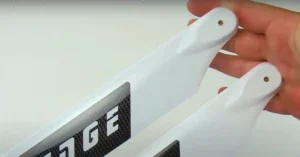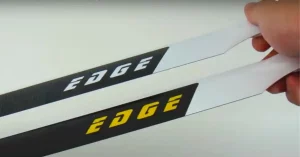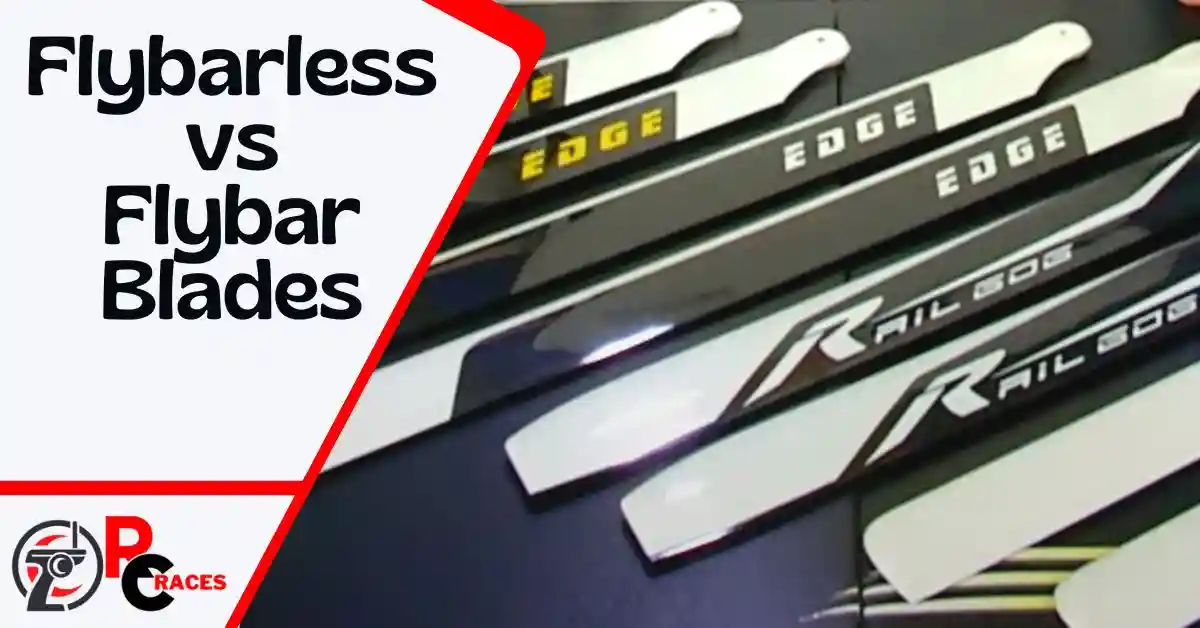Introduction
Most RC helicopter users often side with either flybar or flybarless systems. This makes it harder for newcomers to reach a decision. That’s why many beginners often get confused about which blades to pick.
That being said, what are the differences between flybar vs flybarless blades?
Flybar blades are cheaper but harder to set up. But flybar blades are more agile at the cost of smoother turning. On the contrary, flybarless blades are more stable and provide easier tracking. Flybarless blades are easier to tune and repair. That’s why flybarless blades are more beginner friendly.
Anyways, that was a short comparison between flybar and flybarless blades. There’s a lot more to discuss, mention and elaborate on.
Simply keep reading till the end and you’ll be making a decision in no time.
Flybar Blades vs Flybarless Blades: Primary Differences
In the RC helicopter community, both flybar and flybarless blades are equally appreciated. But that doesn’t mean they’re similar or equal in many fields.
In fact, they tend to be really different in some categories. That’s why you’ll need to know the differences before you make the final decision.
This comparison is quite similar to comparing 2-blades quadcopters with 3-blade quadcopters. Although they are almost the same in reality, they’re very different.
To make it easier for you, we’ve brought all the differences under one table. This will make the flybar vs flybarless blades debate easier to understand.
Here’s what you’re looking for-
| Factors | Flybar Blades | Flybarless Blades |
| Price Range | Cheaper | Expensive |
| Blade Setup | Complex & Time-consuming | Simple & Fast |
| Weight | Lighter; weight is centered | Heavier; weight is at the tip |
| Agility | Higher | Decent |
| Maneuverability | Hard | Easy |
| Stability | Low | High |
| Response | Better | Moderate |
| Tracking | Decent | Easier |
| Servo Requirement | Normal Servo | High-end Servo |
| Vibration Susceptibility | Less | More |
| Damage Susceptibility | More | Less |
| Tuning Difficulty | Hard | Easy |
| Maintenance and Repair | Hard | Easy |
| Beginner Friendly | No | Yes |
| Get Them Now |
After going through the table, which blades do you appreciate more?
Flybar Blades vs Flybarless Blades: Detailed Comparison
If you haven’t picked a winner yet, that’s totally alright. In this section, we’ll compare both blades head to head in every category.
Blades have always been a crucial part of RC helicopters. Depending on the blades, your flying session will be different.
That’s why we suggest that you carefully go through all the categories.
Price Range
The budget is always the biggest concern for most buyers or RC enthusiasts. That’s why we decided to open the comparison with this category.
Flybar blades have been popular for a while. They’re more popular and older than the flybarless blades. They’re more available in shops and common in many RC helicopter builds.
Because of this reason, flybar blades are found to be cheaper than flybarless blades. That’s why most flybar helicopter setups are cheaper overall.
On the contrary, flybarless blades are comparatively newer. They’re slightly more expensive and less available.
But on the bright side, they’re getting famous and more companies have started making them.
Another reason for flybarless blades being expensive is the weight distribution. Unlike the flybar blades, the weight is focused at the tip instead of the center.
Winner: Flybar blades are cheaper.
Blade Setup
After the price range, the biggest difference between flybar and flybarless blades is their setup. Setting the blades properly is considered an extremely important part of flying.
Because otherwise, your RC helicopter is going to crash no matter what.
This is where flybarless blades shine more than flybar blades. Flybar blades are harder to set up because the system follows a complex mechanical system.
A flybar helicopter has flybar blades, mixing arms, swashplates, washout arms, etc. All of these need to be set up each time you set up the blades.
This is time-consuming and it can get messy if you don’t know the system well. If the combinations of these parts aren’t correct, your helicopter is bound to crash.
But this isn’t the case when it comes to flybarless blade systems. Because flybarless helicopters have a simpler system.
Simply make the driver align with the head at a 90-degree angle. You’re all good to go. This is significantly easier and takes no time to set up.
Winner: Flybarless blades win the round.
Blade Weight

The overall weight of the blades makes flybar and flybarless blades different. On top of that, their weight distribution is also different.
Flybar blades are generally lighter than flybarless blades. Because of this reason, many RC helicopter pros tend to prefer this instead.
The weight is distributed towards the center of the blade. This improves the stability of the helicopter.
On the other hand, flybarless blades are heavier. It’s because the flybarless helicopters already lack the flybars. This makes them super unstable.
Some extra weight in the flybarless blades helps add some stability. The weight is also focused on the tip of the blade instead.
This improves the overall stability even further.
Winner: Flybar blades are lighter.
Agility

For a lot of RC helicopter enthusiasts, agility is one of the most important factors. After all, part of the fun lies in flying as fast as possible.
If you’re looking for agility, you’ll have to go for flybar blades. They’re lighter and more agile in nature.
In fact, a lot of users use flybar blades on flybarless helicopters to improve agility.
On the other hand, the agility of flybarless blades is pretty decent. These blades aren’t as fast as flybar blades.
Winner: Flybar blades are more agile.
Maneuverability
Being able to turn your helicopter easily adds comfort to your flying session. That’s why maneuverability is one of the primary priorities.
When it comes to maneuverability, flybar blades are way behind the flybarless blades. They depend on the flybars and the overall mechanical system.
Because of this reason, turning flybar helicopters are comparatively harder than flybarless helicopters.
On the contrary, flybarless blades are independent. They don’t rely on flybars and the overall system is simpler. You can turn your helicopter faster with flybarless blades.
Winner: Flybarless blades are better at overall turning.
Stability

Like agility or maneuverability, stability is also an important factor. Without proper stability, your flying session will be miserable.
That’s why having great stability is a key component for any helicopter.
If you prefer top-notch stability, flybar blades aren’t the way to go. They require a lot of mechanical configuration to be stable.
You’ll need to make sure flybars, washout arms, mixing arms, and swashplates are placed perfectly. Even with everything stable, flybar blades won’t be as stable as flybarless blades.
But flybarless blades only rely on the servo and a gyro to be stable. As a result, keeping a flybarless helicopter stable is easier.
Winner: Flybarless blades are more stable.
Response and Tracking
Flying becomes more enjoyable when your helicopter is responding to your commands perfectly. It gets better when you can track the helicopter the way you want to.
That’s why users look for good responses and tracking in a helicopter system. Checking the response and tracking is often parts of troubleshooting an S107 helicopter.
Flybar blades are better with the overall response. But they’re not extraordinary when it comes to tracking. This creates a sort of min-max situation.
On the contrary, flybarless blades are pretty decent with the response. They’re not as responsive as flybar blades. But they make up for it by being better at tracking.
If you want a helicopter that’s easier to keep on track, pick flybarless blades.
Winner: Flybar blades have a better response. But flybarless blades provide easier tracking.
Servo Requirement
Alright! so far we’ve only talked about the mechanical section of the helicopter. Now, we’re on to the electrical part.
Servo motors are responsible for turning a helicopter. In simple words, servo motors need to be great for a helicopter that turns well.
But in a flybar helicopter, the system already depends on the head mechanically. Because of this reason, flybar helicopters don’t need a strong servo in the first place.
If you’re planning to install flybar blades, simply pick an average servo and that’s it.
But flybarless helicopters primarily depend on the servo and the gyro. That’s why your servo needs to be top of the line.
Otherwise, it’ll create performance issues and average servos will wear out faster.
Speaking of servo motors, here’s what our experts recommend-
You pick whichever product you like the most and get started!
Final Verdict: Which One Should You Pick?

If you’re still confused and facing a dilemma, that’s alright. This comparison is toe-to-toe and picking a side is indeed difficult.
If you’re a beginner, flybarless blades are a better option. It’s easier to tune, easier to repair, more stable, etc.
Flybarless blades make a helicopter more maneuverable too. But the downside is that it’s expensive. Flybarless helicopters are perfect while you’re learning how to fly an RC helicopter.
But flybar helicopters are loved by users that prefer speed and agility. The blades are lighter, providing a better response. You also don’t need a high-end servo for flybar blades.
Tuning can be difficult but once you know the basics, flybar helicopters will seem great.
FAQs
How does a helicopter flybar work?
Flybars are added to helicopters to provide stability. Flybars have extra weight at each end of the paddle. This helps the helicopter maintain a plane of rotation constantly. This also dampens the swashplate steering and wind forces. Steering is the internal and wind is the external force.
Are bigger RC helicopters easier to fly?
Yes, bigger RC helicopters are easier to fly because they have better stability. They’re also easier to control and move around. On top of that, the wind has less effect on a bigger RC helicopter. Besides all of these, bigger RC helicopters are easier to see with your eyes while flying.
What is gyro gain in RC Helis?
Gyro gain means how the tail is going to be corrected when a helicopter drifts. A gyro corrects the tail so it can’t be too aggressive or less aggressive. If a gyro is too aggressive, it’ll correct too fast and cause an imbalance. But if it’s not aggressive enough, gyro wouldn’t be able to keep up.
Take Away
That was everything we could deliver on flybar vs flybarless. We hope that this comparison was able to shed some light on the matter.
You can check out hobby shops and try both systems yourself. That way you can get an experience first-hand.
Finally, have a nice day and happy flying!


